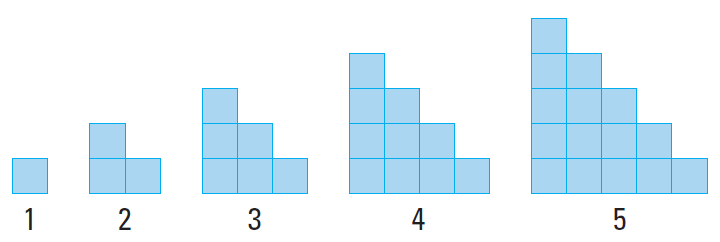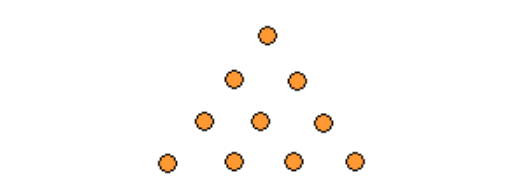PATTERNS AND INDUCTIVE REASONING WORKSHEET
Subscribe to our ▶️ YouTube channel 🔴 for the latest videos, updates, and tips.
Problem 1 :
Sketch the next figure in the pattern.

Problem 2 :
Describe a pattern in the sequence of numbers. Predict the next number.
1, 4, 16, 64, ............
Problem 3 :
Describe a pattern in the sequence of numbers. Predict the next number.
-5,-2, 4, 13, ............
Problem 4 :
Look carefully at the following figures. Then use inductive reasoning to make a conjecture about the next figure in the pattern.

Problem 5 :
Look at the pattern below. Can we draw the next figure or next set of dots using inductive reasoning?


1. Answer :

Each figure in the pattern looks like the previous figure with another row of squares added to the bottom. Each figure looks like a stairway.
So, the sixth figure in the pattern must have six squares in the bottom row.

2. Answer :
1, 4, 16, 64, ............
Each number is four times the previous number.
So, the next number is 256.
3. Answer :
-5,-2, 4, 13, ............
When we look at the above sequence of numbers, the following pattern comes into picture.
When we add 3 to the first number "-5", we get the second number "-2". To get the third number, we have to add 6 to the second number "-2". To get the fourth number, we have to add 9 to the third number "13".
So, the above sequence of numbers is being generated by adding the consecutive multiples of 3. To get the fifth number, we have to add the next multiple of three, which is 12 to the fourth number.
Then, the number is 13 + 12 = 25.
4. Answer :

If we have carefully observed the above pattern, we can have the following points.
(i) In the first figure, the shaded portion is at the top left corner.
(ii) In the second figure, the shaded portion is at the top right corner.
(iii) In the third figure, the shaded portion is at the bottom right corner.
Thus, in the fourth figure, we must have the shaded portion at the bottom left corner as given below.

5. Answer :

The trick is to see that one dot is always placed between and above two dots.
At the very bottom row, we have one dot in the first figure, two dots in the second figure and three dots in the third figure.
Thus, the next figure must have four dots at the very bottom row.
Keeping this in mind, our next figure must look like this :

Subscribe to our ▶️ YouTube channel 🔴 for the latest videos, updates, and tips.
Kindly mail your feedback to v4formath@gmail.com
We always appreciate your feedback.
About Us | Contact Us | Privacy Policy
©All rights reserved. onlinemath4all.com

Recent Articles
-
90 Degree Clockwise Rotation
Jan 01, 26 06:58 AM
90 Degree Clockwise Rotation - Rule - Examples with step by step explanation -
US Common Core K-12 Curriculum Algebra Solving Systems of Equations
Jan 01, 26 04:51 AM
US Common Core K-12 Curriculum - Algebra : Solving Systems of Linear Equations -
Solving the HARDEST SAT Math Questions ONLY using Desmos
Dec 31, 25 05:53 AM
Solving the HARDEST SAT Math Questions ONLY using Desmos
